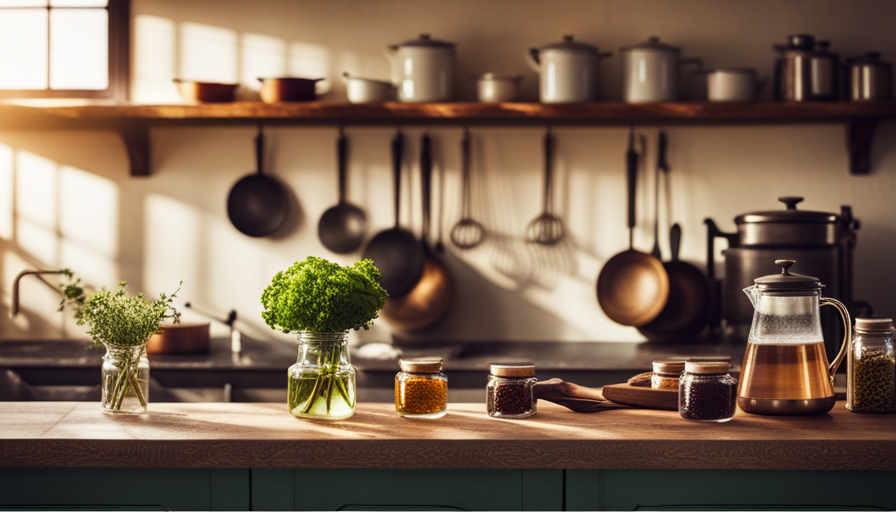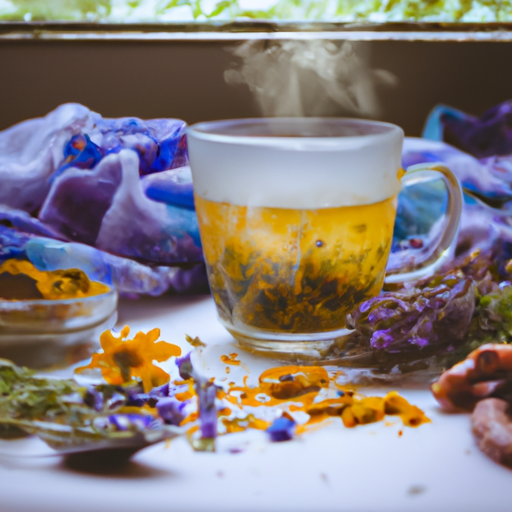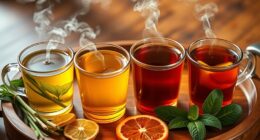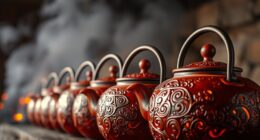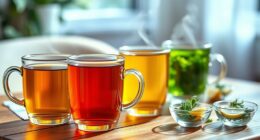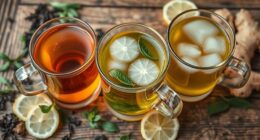Have you ever desired a hot, comforting drink that not only excites your taste buds but also offers a wide range of health advantages? Explore the realm of herbal tea for the perfect solution!
As I embark on this flavorful journey, I can’t help but marvel at the aromatic herbs and botanicals that make each cup a delightful experience.
In this article, I will guide you through the art of brewing herbal tea, a process that requires patience, precision, and a touch of creativity. From selecting the perfect blend to steeping it to perfection, you will learn the secrets of creating a cup of pure bliss.
So, grab your favorite mug and join me as we unlock the wonders of herbal tea, one sip at a time. Get ready to discover a world of flavors and embrace the countless benefits that herbal tea has to offer.
Let’s dive in!
Key Takeaways
- Brewing herbal tea requires patience, precision, and creativity.
- Fresh herbs and good quality tea leaves are essential for flavorful tea.
- Water temperature affects the taste and aroma of herbal tea.
- Experiment with different sweeteners and flavor variations to create a personalized herbal tea experience.
Choose Your Favorite Herbal Tea Blend
Once you’ve explored the wide array of herbal tea blends available, it’s time to choose your favorite and embark on a delicious journey of flavors and aromas.
Explore unique herbal tea blends that suit your taste preferences and provide the benefits you seek. Whether you’re looking for a soothing blend to relax after a long day or a refreshing option to invigorate your senses, there’s a herbal tea blend out there for everyone.
Discover the benefits of herbal tea for relaxation, as it’s been used for centuries to calm the mind and promote a sense of tranquility. Chamomile tea, for example, is known for its soothing properties and can help alleviate stress and anxiety. Lavender tea is another popular choice, with its aromatic scent and calming effects on the body. Peppermint tea is not only refreshing, but it can also aid in digestion and relieve muscle tension.
Once you’ve chosen your favorite blend, gather your ingredients and equipment to start brewing your herbal tea. By following these simple steps, you’ll be able to enjoy a comforting cup of herbal tea in no time.
Gather Your Ingredients and Equipment
To start making your delicious cup of herbal tea, you’ll need some simple ingredients and basic equipment. Here are four items you’ll need to gather:
-
Fresh herbs: Use fresh herbs to enhance the flavor and aroma of your herbal tea. Explore different options like chamomile, mint, lavender, or lemongrass to find your favorite blend.
-
Tea leaves: Whether you choose loose tea leaves or tea bags, make sure they’re of good quality. Loose tea leaves allow for better infusion and a more flavorful cup of tea.
-
Water: Opt for filtered or spring water to ensure a clean and pure taste. Avoid using tap water, as chlorine or other chemicals can affect the flavor.
-
Tea infuser or strainer: If you’re using loose tea leaves, a tea infuser or strainer will help separate the leaves from the liquid. This ensures a smooth and enjoyable tea-drinking experience.
Choosing the right brewing method and using fresh herbs have their own benefits. The brewing method affects the strength and taste of the tea, so consider options like steeping, decoction, or cold brewing. Using fresh herbs adds natural and vibrant flavors to your tea, enhancing its health benefits and overall taste.
Now that you’ve gathered your ingredients and equipment, let’s move on to the next step of measuring and preparing the tea leaves and herbs.
Measure and Prepare the Tea Leaves and Herbs
Get ready to create a flavorful cup of aromatic goodness by measuring and prepping your tea leaves and herbs! When it comes to measuring techniques, it’s important to use the right amount of tea leaves and herbs for the perfect brew.
The general rule of thumb is to use one teaspoon of tea leaves or herbs per cup of water. However, this can vary depending on personal preference and the strength of flavor you desire. If you like a stronger brew, you can increase the amount of tea leaves or herbs accordingly.
Before measuring, it’s a good idea to familiarize yourself with the health benefits of different herbs. For example, chamomile is known for its calming properties, while peppermint can help with digestion. By understanding the unique benefits of each herb, you can create a tea blend that not only tastes great but also provides added health benefits.
Now that you have measured your tea leaves and herbs, it’s time to move on to the next step: heating the water to the optimal temperature. This is crucial for extracting the flavors and medicinal properties of the tea leaves and herbs.
So let’s dive into the world of water temperatures and how they affect your brew!
Heat the Water to the Optimal Temperature
Ready to make the perfect cup of tea? Let’s talk about heating the water to the optimal temperature for a delicious and satisfying brew! Achieving the perfect water temperature is crucial when it comes to brewing herbal tea. Different water temperatures can greatly affect the taste and aroma of your tea, so pay close attention to this step.
For delicate herbal teas such as chamomile or peppermint, it’s best to use water that’s been heated to around 180°F (82°C). This temperature allows the delicate flavors and essential oils to be released without overpowering the tea. On the other hand, if you’re brewing stronger herbal teas like ginger or hibiscus, aim for a slightly higher temperature of around 200°F (93°C). This’ll help extract the robust flavors and create a more robust and full-bodied cup of tea.
To ensure you reach the right temperature, I recommend using a kitchen thermometer or an electric kettle with temperature control. This’ll give you precise control over the water temperature and ensure consistent results every time. Avoid using boiling water as it can scorch the leaves and result in a bitter taste.
Now that we’ve covered how to achieve the perfect water temperature, let’s move on to the next step: steeping your herbal tea to perfection. By allowing the tea to steep for the correct amount of time, you can unlock the full flavor and benefits of the herbs.
Steep Your Herbal Tea to Perfection
Now that the water’s at the optimal temperature, it’s time to steep your herbal tea to perfection! Did you know that steeping your tea for too long can result in a bitter taste? To ensure you get the best flavor from your herbal tea, follow these steps:
-
Timing’s crucial: Different types of herbal teas require different steeping times. For example, chamomile tea should be steeped for around 5 minutes, while peppermint tea needs only 3 minutes. Be sure to check the packaging or consult a reliable source for the recommended steeping time.
-
Use the right amount of tea: It’s important to use the correct ratio of tea to water. Too little tea will result in a weak flavor, while too much can make it overpowering. As a general guideline, use 1 teaspoon of loose tea or 1 tea bag per cup of water.
-
Keep an eye on the water temperature: Even though the water was heated to the optimal temperature earlier, it may cool down slightly during the steeping process. If this happens, you can gently reheat it to maintain the desired temperature.
-
Avoid common steeping mistakes: One mistake to avoid is stirring the tea while it’s steeping. This can release tannins and result in a bitter taste. Also, don’t squeeze the tea bag or press the leaves too hard as it can extract unwanted bitterness.
Now that your herbal tea’s steeped to perfection, it’s time to strain and serve your refreshing beverage.
Strain and Serve Your Herbal Tea
Once your herbal tea has steeped to perfection, it’s time to strain out the leaves and pour yourself a soothing cup of goodness. Straining your tea is an important step to ensure a smooth and enjoyable drinking experience.
There are several methods you can use to strain your herbal tea, depending on your personal preference and the tools you have on hand.
One popular method is to use a fine mesh strainer or a tea infuser. Simply place the strainer or infuser over your cup, and slowly pour the tea through it. The fine mesh will catch any loose leaves, allowing only the flavorful liquid to pass through.
Another option is to use a cheesecloth or muslin cloth. Place the cloth over a bowl or pitcher, and carefully pour the tea through it. The cloth will act as a filter, removing any sediment or debris from the liquid.
Once your tea is strained, it’s ready to be served. Pour it into your favorite mug or teacup, and enjoy the fragrant aroma and soothing taste.
You can also add sweeteners or enhancements, such as honey, lemon, or fresh herbs, to customize your herbal tea to your liking. These additions can complement the natural flavors of the herbs and create a more satisfying drinking experience.
So go ahead, strain and serve your herbal tea, and get ready to indulge in a moment of relaxation and rejuvenation.
Add Sweeteners or Enhancements (Optional)
To take your cup of herbal goodness to the next level, why not sprinkle in a touch of sweetness or a burst of flavor with your favorite sweeteners or enhancements? Adding these extras to your herbal tea can elevate the taste and provide a unique experience.
Here are some options to consider:
-
Sweeteners: Enhance the natural flavors of your herbal tea by adding a sweetener. You can use honey, maple syrup, or stevia for a healthier alternative to sugar. Experiment with different amounts to find your desired level of sweetness.
-
Citrus Zest: Add a vibrant and refreshing twist to your herbal tea by including citrus zest. Lemon, lime, or orange zest can infuse your drink with a tangy and invigorating flavor.
-
Spices: Spice up your herbal tea with a pinch of cinnamon, cloves, or ginger. These warm and aromatic spices can create a cozy and comforting drink, perfect for chilly evenings.
-
Fresh Herbs: If you want to enhance the herbal notes in your tea, try adding fresh herbs like mint, basil, or lavender. These herbs can complement the existing flavors and provide a delightful fragrance.
By experimenting with different sweeteners and flavor variations, you can create a personalized and unique herbal tea experience. Once you’ve perfected the taste, it’s time to sit back, relax, and enjoy your homemade herbal tea.
Enjoy Your Homemade Herbal Tea
Savor the pure bliss of indulging in your very own crafted infusion of natural wonders. After all the effort put into brewing your herbal tea, it’s time to sit back, relax, and enjoy the fruits of your labor. Homemade tea recipes offer a plethora of benefits, both for your taste buds and your well-being.
As you take a sip, allow the warm liquid to engulf your senses, comforting and soothing you from within. Feel the gentle embrace of the herbs as they work their magic in your body, providing a sense of calm and rejuvenation. Herbal tea is not just a beverage; it’s a wellness elixir.
To help you visualize the pleasure of indulging in your homemade tea, imagine a table with two columns and five rows. On one side, you have a steaming cup of fragrant chamomile tea, while on the other, a delicate blend of lavender and mint. In the rows below, picture the vibrant hues of hibiscus, the earthy notes of nettle, and the refreshing taste of lemon balm. Each sip offers a unique sensory experience.
So go ahead and explore different herbal tea blends, unlocking a world of flavors and benefits. Discover the wonders that lie in the perfect combination of herbs and embrace the journey of creating your own personalized cup of herbal bliss.
Explore Different Herbal Tea Blends
When it comes to exploring different herbal tea blends, I love to experiment with different combinations. Mixing various herbs together allows me to create unique flavors and aromas that I can’t find in store-bought teas.
It’s an exciting journey of discovering new tastes and finding the perfect blend that suits my personal preferences. So, if you’re looking to expand your tea collection and try something different, I highly recommend exploring the world of herbal tea blends.
Experiment with Different Combinations
Get creative and try out various combinations of herbs to brew the most delightful and unique herbal tea blends. Here are four exciting ways to experiment with unique flavors and create your own tea blends:
-
Mix chamomile and lavender for a calming and soothing blend that’s perfect for relaxation before bedtime.
-
Combine peppermint and lemon balm for a refreshing and invigorating blend that’ll wake up your senses in the morning.
-
Try blending hibiscus and rosehips for a tart and tangy tea that’s full of antioxidants and vitamin C.
-
For a floral and aromatic blend, mix rose petals with jasmine and enjoy the delicate scent and taste.
By exploring different combinations of herbs, you can discover new flavors and aromas that’ll elevate your herbal tea experience.
Discover New Flavors and Aromas
Indulging in a variety of herb combinations can unveil a realm of novel and enticing flavors and aromas to enhance your tea experience. To truly discover new flavors and aromas, it is important to try unique herbal blends and experiment with different combinations. Each herb brings its own distinct characteristics to the table, and when combined, they create a symphony of taste and scent. To help you get started on your herbal tea journey, here is a table showcasing some popular herbs and their flavor profiles:
| Herb | Flavor Profile |
|---|---|
| Chamomile | Floral, apple-like, and slightly sweet |
| Peppermint | Refreshing, minty, and cooling |
| Lavender | Floral, herbaceous, and slightly sweet |
| Hibiscus | Tart, fruity, and slightly floral |
| Lemongrass | Citrusy, lemony, and slightly sweet |
Finding the perfect brewing time for each blend is key to extracting the best flavors and aromas. So, experiment with different steeping times to achieve the desired taste. Now, let’s delve into the health benefits of herbal tea and explore how it can improve your well-being.
Discover the Health Benefits of Herbal Tea
Discover the amazing health benefits that herbal tea can offer. Herbal teas aren’t just delicious and soothing, but they also provide a wide range of health benefits.
From boosting the immune system to aiding digestion, there are numerous reasons to incorporate herbal teas into your daily routine.
One of the greatest health benefits of herbal tea is its ability to support the immune system. Many herbal teas, such as echinacea and elderberry, are known for their immune-boosting properties. These teas contain antioxidants and vitamins that can help strengthen the immune system and fight off infections.
Herbal teas also offer a variety of other health benefits. For example, chamomile tea is well-known for its calming properties and can help reduce anxiety and promote better sleep. Peppermint tea is great for soothing an upset stomach and relieving digestive issues. Ginger tea can help with nausea and alleviate menstrual cramps.
There are numerous types of herbal teas available, each with its own unique health benefits. Some popular options include green tea, rooibos tea, and hibiscus tea. Green tea is packed with antioxidants and can help improve brain function and promote weight loss. Rooibos tea is known for its anti-inflammatory properties and can help with allergies and skin conditions. Hibiscus tea is rich in vitamin C and can help lower blood pressure.
Incorporating herbal tea into your daily routine is a simple and delicious way to promote overall health and wellness. Whether you’re looking to boost your immune system, improve digestion, or simply relax and unwind, there’s an herbal tea out there for you. So why not brew a cup today and start reaping the amazing health benefits that herbal tea has to offer?
Frequently Asked Questions
What are some common health benefits of herbal tea?
Herbal tea offers a plethora of health benefits that are as diverse as the common herbal tea flavors themselves. From soothing chamomile to invigorating peppermint, these teas can provide relief from various ailments. They’re known to boost the immune system, aid digestion, reduce inflammation, and promote relaxation.
To fully enjoy these benefits, it’s important to store herbal tea properly in a cool, dry place away from moisture and strong odors.
How long does herbal tea stay fresh?
The shelf life of herbal tea depends on various factors, such as the type of herbs used, the packaging, and storage conditions. Generally, loose leaf herbal tea can stay fresh for about 6 to 12 months, while tea bags may last for 8 to 12 months.
To maximize freshness, store herbal tea in an airtight container in a cool, dark place away from moisture, heat, and strong odors. This will help preserve its flavor, aroma, and health benefits.
Can I reuse the tea leaves and herbs for a second steeping?
Absolutely! You can reuse tea leaves and herbs for a second steeping. It’s a great way to maximize flavor and get the most out of your ingredients. By doing this, you can extract additional subtle flavors and aromas that may have been missed during the first steeping. To achieve the best results, adjust the brewing time and temperature slightly to account for the leaves’ previous infusion. Experiment with different brewing techniques to find the perfect balance for your taste buds.
What are some popular herbal tea blends for relaxation?
Popular herbal tea blends for relaxation include chamomile, lavender, and valerian root.
Chamomile tea is known for its calming properties and can help with sleep.
Lavender tea can help reduce stress and anxiety.
Valerian root tea is often used as a natural remedy for insomnia.
Each herbal tea flavor has unique benefits, so it’s worth experimenting with different blends to find the one that works best for you.
Can I drink herbal tea if I have certain dietary restrictions or allergies?
If you have gluten intolerance, you can still enjoy herbal tea because it’s naturally gluten-free. There are plenty of herbal tea options available for those with dietary restrictions.
For lactose intolerant individuals, herbal teas made from plants like chamomile, peppermint, or ginger are great choices as they don’t contain lactose. These teas can provide a soothing and refreshing experience without triggering any allergies or dietary issues.
Conclusion
In conclusion, brewing herbal tea is a simple and enjoyable process that allows you to create a delicious and healthy beverage right in the comfort of your own home. By following the steps outlined in this article, you can experiment with different herbal tea blends and discover your favorite flavors.
Did you know that herbal tea has been consumed for centuries and is known for its various health benefits? From boosting immunity to aiding digestion, herbal tea is a wonderful addition to any wellness routine. So why not start brewing your own herbal tea today and reap the benefits of this ancient beverage?

